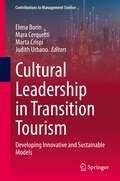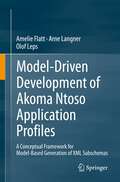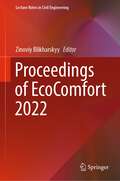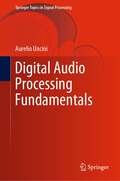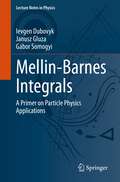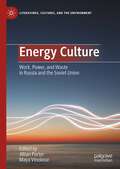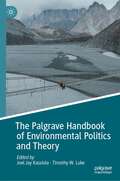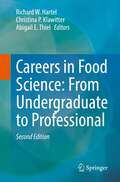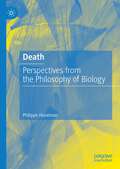- Table View
- List View
Emerging Nanotechnologies in Nanocellulose (NanoScience and Technology)
by Liangbing Hu Feng Jiang Chaoji ChenThis book provides expert coverage of the current state of the art in the application of nanotechnologies to cellulose research. It offers a comprehensive collection of topics including nanocellulose isolation, assembly into hierarchical structures, and advanced emerging applications. During the past decades, research in nanocellulose has advanced quickly, driven by the urgent needs for sustainability and the availability of advanced nanotechniques. Although cellulose has been investigated and used for thousands of years, the recent advances in nanotechnology have transformed our view of this natural substance. Cellulose, when present in the highly crystalline nanoscale form, can demonstrate interesting mechanical, optical, and fluidic properties that can be manipulated in designing materials with novel applications.This book contains 12 chapters. Chapter 1 focuses primarily on the fundamentals of nanocellulose, including general aspects on its structure, isolation, and characterization. Chapters 2-4 summarize the recent progress on assembly of nanocellulose into the macroscopic scale using state-of-the-art techniques. Chapters 5-13 cover the most advanced applications of nanocellulose in emerging areas, including superstrong materials, light management, electronics, energy storage, printed battery, water treatment, nanogenerator, and biomedicine. The book will appeal to upper undergraduate and graduate students through practicing researchers as a comprehensive reference on the subject of nanocellulose and its use in various fields.
Cities and Mega Risks: COVID-19 and Climate Change
by Mohammad Aslam KhanThis book focuses on the emergence of COVID-19 and climate change as twin mega risks to cities of both developed and developing countries. The work analyses how the pandemic has transformed city functions, promoted remote working, and affected socializing, education and learning patterns, recreation, as well as shopping and entertainment. It discusses the lessons learned from these two Mega Risks, the evolution of urban patterns and functions in their wake, and provides visionary thinking for the improvement of cities from the experiences gained. The COVID-19 Pandemic and climate change are both posing serious threats to cities’ future. Together, they demand changes in the ways cities’ function and operate. The work presents a case for a better understanding of the twin mega risks, the magnitude of their impacts, the responses of cities in combating these issues, and planning strategies for preparing, mitigating and adapting to these and future risks. The book is designed to provide reliable resource materials for a wide audience such as planners, professional practitioners, scientists, students, teachers and researchers working in various fields including geography, environmental sciences, social sciences, policy and planning.
Application of Remote Sensing and GIS in Natural Resources and Built Infrastructure Management (Water Science and Technology Library #105)
by Vijay P. Singh Shalini Yadav Krishna Kumar Yadav Gerald Augusto Corzo Perez Francisco Muñoz-Arriola Ram Narayan YadavaThis book discusses the problems in planning, building, and management strategies in the wake of application and expansion of remote sensing and GIS products in natural resources and infrastructure management. The book suggests proactive solutions to problems of natural resources and infrastructure management, providing alternatives for strategic planning, effective delivery, and growth perspectives. The uniqueness of the book is its broader spectrum of coverage with related interconnections and interdependences across science, engineering, and innovation. The book contains information that can be downscaled to the local level. Presenting a wide spectrum of viewpoints and approaches, the book is a collective of topics such as application to agriculture and forestry (land and landscape, agriculture, forestry management and deforestation), water resources and ecology (hydro-meteorological, climate diagnostics, and prognostics, water resources management, environment management, cross-scale ecology and resilience), urban management (urban planning, design, construction and operations of infrastructure, natural disasters, novel approaches to upgrade old infrastructure), hydro informatics, predictive and geospatial data analytics, synthesis, and management through the various processes, tools, and technologies.
Tubercular Drug Delivery Systems: Advances in Treatment of Infectious Diseases
by Yashwant Pathak Ranjita ShegokarThe book targets new advances in areas of treatment and drug delivery sciences for tuberculosis. It covers advances in drug therapy and drug targeting that focus on innovative trend defining technologies and drug delivery platforms in the understanding of host-pathogens relationship for providing better therapy. A wide variety of novel and nano-formulations using promising technologies are being explored to deliver the drug via different administration routes. This book It addresses the gap between new approaches and old treatment modalities and how they are superior in pharmacological performance when tested in in-vitro and in-vivo. Audience from wide range group like from researchers to regulatory bodies can benefit from the compiled information to find out patient needs and current research advances in the field of tuberculosis research..
Cultural Leadership in Transition Tourism: Developing Innovative and Sustainable Models (Contributions to Management Science)
by Elena Borin Mara Cerquetti Marta Crispí Judith UrbanoCultural tourism has proved to be a significant source of economic development for cultural destinations, but it has also emerged as a sometimes potentially controversial and unsustainable phenomenon. The recent pandemic has also pointed out that we need different models of development of tourism, that include a more balanced approach to cultural components in cities and rural areas. Calls have been made on the need to design more sustainable models of tourism development for cultural destinations, conceiving tourism as a means to increasing the quality of life and generating economic opportunities in cities and regions by involving their communities and stakeholders. This book presents an in-depth analysis of the transition towards more sustainable models of cultural tourism development. Starting from the ongoing debate on cultural ecosystems, the book explores the potential key role of cultural and creative organizations as leaders of change. Including theoretical contributions, quantitative and qualitative analyses and international case studies, the book explores the role of cultural actors as leaders and their potential as drivers of culture-led innovation for tourism in cities and regions.
Model-Driven Development of Akoma Ntoso Application Profiles: A Conceptual Framework for Model-Based Generation of XML Subschemas
by Amelie Flatt Arne Langner Olof LepsThis book presents a model-driven approach for creating a national application profile of the international legislative document standard Akoma Ntoso (AKN). AKN is an XML-based document standard that serves as the basis for modern machine-readable and fully digital legislative and judicial processes. The described model-driven development approach ensures consistent and error-proof application of AKN concepts and types, even when using different software tools. It allows for easy maintenance, is self-documenting, and facilitates stakeholder validation with nontechnical legal experts. The resulting application profile remains fully compliant to and compatible with AKN. For the sake of illustration, the approach is paradigmatically applied to the German federal legislative process, as a corresponding approach was used in the creation of the German AKN application profile, LegalDocML.de. We discuss how the methodology yields a model, schema definition and specification that correspond to the artefacts created by LegalDocML.de, using examples from Germany. The book is of interest to both legal and technical project teams on the cusp of introducing AKN in a legislative domain and intended as a practical guideline for teams preparing to create a custom application profile for their own domain. Furthermore, it can serve as both a resource and an inspiration for similar and yet to be developed methodologies in the public sector, the health sector or in defense, where international standardization and interoperability efforts are to be applied to a local level.
Proceedings of EcoComfort 2022 (Lecture Notes in Civil Engineering #290)
by Zinoviy BlikharskyyThis book gathers the latest innovations and applications in the field of resource-saving technologies and advanced materials in civil and environmental engineering, as presented by leading international researchers and engineers at the 3rd International Scientific Conference EcoComfort and Current Issues of Civil Engineering, held in Lviv, Ukraine on September 14-16, 2022. It covers a diverse range of topics, including ecological and energy-saving technologies; renewable energy sources; heat, gas and water supply; microclimate provision systems; innovative building materials and products; smart technologies in water purification and treatment; protection of water ecosystems; and architectural shaping and structural solutions. The contributions, which were selected using a rigorous international peer-review process, highlight exciting ideas that will spur novel research directions and foster multidisciplinary collaborations.
Human Evolution: Bones, Cultures, and Genes (Springer Texts in Social Sciences)
by John H. LangdonThis is an introductory textbook for the study of human evolution, and covers all major topics of human origins taught under paleoanthropology, anthropology, archaeology, and evolutionary biology courses. This book differs from the existing selection of textbooks in the following ways:• It incorporates the most recent fossil discoveries and interpretations.• It balances the discussion between descriptions of fossils and interpretations of behavior of hominins in different time periods. • It includes current findings of genomics into understanding the more recent stages of human evolution. This important subdiscipline is badly underserved by current texts.• It consistently addresses the relationship of evidence to our current hypotheses and interpretations.The book has an engaging and lucid style suitable for those entering the field. Students will find ample case studies, illustrations and examples helpful in understanding difficult concepts. Tables, timelines, and maps in every chapter include data summaries and key points. The book highlights peripheral points and background concepts in side boxes for easy reference and lists key ideas at the end of each chapter. This up-to-date and easy to read text is suitable for both classroom study and self-learning.
Oxygen Transport to Tissue XLIII (Advances in Experimental Medicine and Biology #1395)
by Felix Scholkmann Joseph LaManna Ursula WolfThis book contains most of the scientific contributions during the 48th annual conference of the International Society on Oxygen Transport to Tissue (ISOTT), which was held electronically in July 2021. It includes multidisciplinary contributions from scientists (physicists, biologists and chemists), engineers, clinicians and mathematicians and covers covers all aspects of oxygen transport from air to the cells, organs and organisms; instrumentation and methods to sense oxygen and clinical evidence.
Elements of Classical Plasticity Theory
by Andreas ÖchsnerThis monograph provides a compact introduction into the classical, i.e. rate-independent, plasticity theory. Starting from the engineering stress-strain diagram, the concept of elastic and elasto-plastic material behavior is introduced, as well as the concept of uniaxial and multiaxial stress states. Continuum mechanical modeling in the elasto-plastic range requires, in regards to the constitutive equation, in addition to the elastic law (e.g. Hooke’s law), a yield condition, a flow rule and a hardening rule. These basic equations are thoroughly introduced and explained for one-dimensional stress states. Considering three-dimensional plasticity, different sets of stress invariants to characterize the stress matrix and the decomposition of the stress matrix in its hydrostatic and deviatoric part are introduced. Furthermore, the concept of the yield condition, flow rule and hardening rule is generalized for multiaxial stress states. Some typical yield conditions are introduced and their graphical representation in different stress spaces is discussed in detail. The book concludes with an introduction in the elasto-plastic finite element simulation of mechanical structures. In the context of numerical approximation methods, the so-called predictor-corrector methods are used to integrate the constitutive equations. This is again introduced in detail based on one-dimensional stress states and afterwards generalized to the three-dimensional case. Test your knowledge with questions and answers about the book in the Springer Nature Flashcards app.
Digital Audio Processing Fundamentals (Springer Topics in Signal Processing #21)
by Aurelio UnciniThe book provides an accessible overview of audio signal processing, and enables readers to design and write algorithms for the analysis, synthesis, and manipulation of musical and acoustic signals for any programming language. It provides an overview of highly interdisciplinary topics developed in a simple but rigorous way, and described in a unified and formal language which focuses on determining discrete-time audio signal models. Readers can find within a self-contained volume basic topics ranging over different disciplines: mechanical acoustics, physical systems and linear and nonlinear models, with lumped and distributed parameters; described and developed with the same level of mathematical formalism, easy to understand and oriented to the development of algorithms. Topics include the fundamental concepts of acoustic mechanics and vibration; the design of filters and equalizers for sound signals, the so-called audio effects, abstract methods of sound synthesis, and finally, methods of synthesis by physical modeling.
Ecological Money and Finance: Exploring Sustainable Monetary and Financial Systems
by Thomas Lagoarde-SegotThis book provides a detailed overview of ecological money and finance. The functioning and development of the monetary and financial systems are analysed in relation to sustainability constraints to highlight the actions required to meet the 2030 Sustainable Development Agenda. Empirical case studies are utilized to give insight into the failure of the traditional financial system, with ways in which they can be overcome also considered. This book adopts a pluralist perspective to revisit the foundations of financial and monetary economics from a sustainability perspective, and examines the economic and financial instruments that can be used to combat ecological challenges. It will be relevant to students and researchers interested in ecological economics and sustainable finance.
Regional Failure Events in Communication Networks: Models, Algorithms and Applications (Springer Theses)
by Balázs VassThis book presents a comprehensive study covering the design and application of models and algorithms for assessing the joint device failures of telecommunication backbone networks caused by large-scale regional disasters. At first, failure models are developed to make use of the best data available; in turn, a set of fast algorithms for determining the resulting failure lists are described; further, a theoretical analysis of the complexity of the algorithms and the properties of the failure lists is presented, and relevant practical case studies are investigated. Merging concepts and tools from complexity theory, combinatorial and computational geometry, and probability theory, a comprehensive set of models is developed for translating the disaster hazard in informative yet concise data structures. The information available on the network topology and the disaster hazard is then used to calculate the possible (probabilistic) network failures. The resulting sets of resources that are expected to break down simultaneously are modeled as a collection of Shared Risk Link Groups (SRLGs), or Probabilistic SRLGs. Overall, this book presents improved theoretical methods that can help predicting disaster-caused network malfunctions, identifying vulnerable regions, and assessing precisely the availability of internet services, among other applications.
Research in PDEs and Related Fields: The 2019 Spring School, Sidi Bel Abbès, Algeria (Tutorials, Schools, and Workshops in the Mathematical Sciences)
by Kaïs AmmariThis volume presents an accessible overview of mathematical control theory and analysis of PDEs, providing young researchers a snapshot of these active and rapidly developing areas. The chapters are based on two mini-courses and additional talks given at the spring school "Trends in PDEs and Related Fields” held at the University of Sidi Bel Abbès, Algeria from 8-10 April 2019. In addition to providing an in-depth summary of these two areas, chapters also highlight breakthroughs on more specific topics such as:Sobolev spaces and elliptic boundary value problemsLocal energy solutions of the nonlinear wave equationGeometric control of eigenfunctions of Schrödinger operatorsResearch in PDEs and Related Fields will be a valuable resource to graduate students and more junior members of the research community interested in control theory and analysis of PDEs.
Mellin-Barnes Integrals: A Primer on Particle Physics Applications (Lecture Notes in Physics #1008)
by Ievgen Dubovyk Janusz Gluza Gábor SomogyiIn this book, the authors discuss the Mellin-Barnes representation of complex multidimensional integrals. Experiments frontiered by the High-Luminosity Large Hadron Collider at CERN and future collider projects demand the development of computational methods to achieve the theoretical precision required by experimental setups. In this regard, performing higher-order calculations in perturbative quantum field theory is of paramount importance. The Mellin-Barnes integrals technique has been successfully applied to the analytic and numerical analysis of integrals connected with virtual and real higher-order perturbative corrections to particle scattering. Easy-to-follow examples with the supplemental online material introduce the reader to the construction and the analytic, approximate, and numeric solution of Mellin-Barnes integrals in Euclidean and Minkowskian kinematic regimes. It also includes an overview of the state-of-the-art software packages for manipulating and evaluating Mellin-Barnes integrals. The book is meant for advanced students and young researchers to master the theoretical background needed to perform perturbative quantum field theory calculations.
Ten Projects in Applied Statistics (Springer Series in Statistics)
by Peter McCullaghThe first half of the book is aimed at quantitative research workers in biology, medicine, ecology and genetics. The book as a whole is aimed at graduate students in statistics, biostatistics, and other quantitative disciplines. Ten detailed examples show how the author approaches real-world statistical problems in a principled way that allows for adequate compromise and flexibility. The need to accommodate correlations associated with space, time and other relationships is a recurring theme, so variance-components models feature prominently. Statistical pitfalls are illustrated via examples taken from the recent scientific literature. Chapter 11 sets the scene, not just for the second half of the book, but for the book as a whole. It begins by defining fundamental concepts such as baseline, observational unit, experimental unit, covariates and relationships, randomization, treatment assignment, and the role that these play in model formulation. Compatibility of the model with the randomization scheme is crucial. The effect of treatment is invariably modelled as a group action on probability distributions. Technical matters connected with space-time covariance functions, residual likelihood, likelihood ratios, and transformations are discussed in later chapters.
Science Curriculum for the Anthropocene, Volume 1: Complexity, Systems, and Sustainability Perspectives
by Xavier FazioThis volume, the first of a two-volume set, provides a foundation for future research and development in science curriculum. Drawing upon complexity and systems theories, this book provides a framework for science curriculum that tackles and transform the interrelated and socio-ecological causes of our ecological crises in the Anthropocene. Chapters provide a foundational conceptual framework that can inspire and motivate educators and researchers alike, and push the boundaries of science curriculum research, theory, and practice The result is a refreshing and hopeful look at PK-12 science curriculum as a lever for positive change amidst our current global trajectory in the 21st century.
Energy Culture: Work, Power, and Waste in Russia and the Soviet Union (Literatures, Cultures, and the Environment)
by Jillian Porter Maya VinokourThis volume investigates energy as a shaping force in Russian and Soviet literature, visual culture, and social practice. Chronologically arranged chapters explain how nineteenth-century ideas about energy informed realist novels and paintings; how the poetics of energy defined pre-Revolutionary and Stalinist utopianism; and how fossil fuels, electricity, and nuclear fission generated distinct aesthetic features in Imperial Russian, Soviet, and post-Soviet literature, cinema, and landscape. The volume’s concentration on Russia responds to a clear need to understand the role the country plays in social, political, and economic processes endangering life on Earth today. The cultural dimension of Russia’s efforts at energy dominance deserves increased scholarly attention not only in its own right, but also because it directly affects global energy policy. As the contributors to this volume argue, the nationally inflected cultural myths that underlie human engagements with energy have been highly consequential in the Anthropocene.
Recent Advances in Mechanics and Fluid-Structure Interaction with Applications: The Bong Jae Chung Memorial Volume (Advances in Mathematical Fluid Mechanics)
by Fernando Carapau Ashwin VaidyaThis volume examines current research in mechanics and its applications to various disciplines, with a particular focus on fluid-structure interaction (FSI). The topics have been chosen in commemoration of Dr. Bong Jae Chung and with respect to his wide range of research interests. This volume stands apart because of this diversity of interests, featuring an interdisciplinary and in-depth analysis of FSI that is difficult to find conveniently collected elsewhere in the literature. Contributors include mathematicians, physicists, mechanical and biomechanical engineers, and psychologists. This volume is structured into four thematic areas in order to increase its accessibility: theory, computations, experiments, and applications. Recent Advances in Mechanics and Fluid-Structure Interaction with Applications will appeal to established researchers as well as postdocs and graduate students interested in this active area of research.
Ethics and Clinical Neuroinnovation: Fundamentals, Stakeholders, Case Studies, and Emerging Issues
by Laura Weiss RobertsNew ways of understanding the brain – its nature, its capacities, its function, and its dysfunction – hold great promise for human wellbeing. Novel therapeutics spurred by this understanding have important roles addressing many clinical conditions, including Alzheimer Disease, depression, addiction, and obsessive-compulsive disorder. This unique title explores a wide range of groundbreaking sciences and clinical practices for brain-based conditions, including deep brain stimulation, optogenetics, technology-delivered therapies, predictive testing, and new clinical uses of ketamine, cannabis, and other psychoactive substances.An introduction to the imperative to develop new treatments for devastating brain disorders and the state of current therapeutics in psychiatry, addiction, and behavioral disorders is presented, and chapters from leading physician-scientists and neuroethicists outline the clinical and the ethical issues arising in innovation and in the creation of new therapeutics for brain diseases. Written by renowned thought leaders in their fields, the book presents tightly written contributions on novel qualitative and quantitative data from stakeholders in the field, including neuroscientist-clinicians, people living with mental illness and/or addictions, and oversight/policy stakeholders. Concise, anticipatory, and centered on the principles governing human biomedical research and innovation in developing novel therapeutics for brain disorders, Ethics and Clinical Neuroinnovation will be of great value to clinicians, researchers, and students from a vast array of backgrounds, including neuroethics, neuroscience, psychology, psychiatry, philosophy, entrepreneurship, and the law.
The Palgrave Handbook of Environmental Politics and Theory (Environmental Politics and Theory)
by Joel Jay Kassiola Timothy W. LukeThis Handbook aims to provide a unique and convenient one-volume reference work, exhibiting the latest interdisciplinary explorations in this urgently burgeoning field of intellectual and practical importance. Due to its immense range and diversity, environmental politics and theory necessarily encompasses: empirical, normative, policy, political, organizational, and activist discussions unfolding across many disciplines. It is a challenge for its practitioners, let alone newcomers, to keep informed about the ongoing developments in this fast-changing area of study and to comprehend all of their implications. Through the planned volume’s extensive scope of contributions emphasizing environmental policy issues, normative prescriptions, and implementation strategies, the next generation of thinkers and activists will have very useful profiles of the theories, concepts, organizations, and movements central to environmental politics and theory. It is the editors’ aspiration that this volume will become a go-to resource on the myriad perspectives relevant to studying and improving the environment for advanced researchers as well as an introduction to new students seeking to understand the basic foundations and recommended resolutions to many of our environmental challenges. Environmental politics is more than theory alone, so the Handbook also considers theory-action connections by highlighting the past and current: thinkers, activists, social organizations, and movements that have worked to guide contemporary societies toward a more environmentally sustainable and just global order. Chapter “Eco-Anxiety and the Responses of Ecological Citizenship and Mindfulness” is available open access under a Creative Commons Attribution 4.0 International License via link.springer.com.
Careers in Food Science: From Undergraduate to Professional
by Richard W. Hartel Christina P. Klawitter Abigail E. ThielCareers in Food Science provides detailed guidelines for students and new employees in the food industry to ensure a successful start to their career. Every step towards a rewarding career in this rapidly evolving industry is covered, from which classes to take in college and which degrees to earn, to internships, and finally how to land, and keep, the first job. This book also provides day-to-day examples of what to expect from the many jobs available to help students decide what to do and where to go. This second edition includes nine new chapters covering research chefs, food systems, social justice, food waste, start-ups, sustainability, and management. Several new authors offer fresh perspectives.
Elementary Particles and Their Interactions (Graduate Texts in Physics)
by Stephen P. Martin James D. WellsThe Standard Model of elementary particle physics was tentatively outlined in the early 1970s. The concepts of quarks, leptons, neutrinos, gauge symmetries, chiral interactions, Higgs boson, strong force, weak force, and electromagnetism were all put together to form a unifying theory of elementary particles. Furthermore, the model was developed within the context of relativistic quantum field theory, making it compatible with all of the laws of Einstein's Special Relativity. The successes of the Standard Model over the years have been tremendous and enduring, leading up to the recent discovery and continuing study of the Higgs boson. This book is a comprehensive and technical introduction to Standard Model physics. Martin and Wells provide readers who have no prior knowledge of quantum field theory or particle physics a firm foundation into the fundamentals of both. The emphasis is on obtaining practical knowledge of how to calculate cross-sections and decay rates. There is no better way to understand the necessary abstract knowledge and solidify its meaning than to learn how to apply it to the computation of observables that can be measured in a laboratory. Beginning graduate students, both experimental and theoretical, and advanced undergraduate students interested in particle physics, will find this to be an ideal one-semester textbook to begin their technical learning of elementary particle physics.
Raman Spectroscopy in Cultural Heritage Preservation (Cultural Heritage Science)
by Howell G. Edwards Peter Vandenabeele Philippe ColombanThis book addresses the application of Raman spectroscopic techniques to a range of diverse problems which arise in the study, conservation and restoration of artefacts and sites closely related to our cultural heritage as well as in authentication. These themes are naturally wider than what at first might be considered as artworks and archaeological artefacts and the topics include pigments, paintings, ceramics, glass, sculpture and patination / corrosion, textiles, industrial archaeology, the degradation and preservation of biomaterials, mummies and human skeletal remains. An interesting feature is the inclusion of modern case studies which describe specific problems and approaches to the Raman spectral analysis of items important to our cultural heritage. The text is prefaced with an introduction to the important parameters used in nondestructive Raman measurements and also highlights some future applications based upon novel miniaturised instrumentation for in-field studies and potential screening work which will identify specimens which would repay further studies in the laboratory. An attempt is made to give a snapshot of the state-of-the-art evolution since the beginning of the technique (1970s) and to point out potential further development. The book is co-edited by three international experts with many years' experience in the application of Raman spectroscopy to artworks, archaeological artefacts and in the investigation of materials and sites for cultural heritage preservation and each editor has undertaken to write individual chapters and different topics personally. The adopted approach is designed to convey the sort of information which has become available from the adoption of analytical Raman spectroscopy to different problems in the field of cultural heritage preservation through the spectral interrogation of artefacts and how the interpretation of the spectral data can assist museum curators, archaeologists and cultural heritage historians in the preservation and conservation of ancient materials and sites : a particular advantage in this respect is the ability of Raman spectroscopy to determine –generally in a strictly noninvasive procedure - at the laboratory or on-site with mobile instruments, the presence of both organic and inorganic components in a particular specimen together nondestructively without any chemical and mechanical pretreatment being undertaken, which is an essential requirement for rare and valuable samples . An important aside from this work is the means of spectral identification of ongoing biodeterioration and biological colonisation in specimens in storage and the effects of environmental deterioration such as humidity and temperature upon their integrity.
Death: Perspectives from the Philosophy of Biology
by Philippe HunemanThis book addresses several key issues in the biological study of death with the intent of capturing their genealogy, the assumptions and presuppositions they make, and the way that they open specific new research avenues. The book is divided into two sections: the first considers physiology and the second evolutionary biology. Huneman explains that biologists in the late 1950s put forth a research framework that evolutionarily accounts for death in terms of either an effect of the weakness of natural selection or a by-product of natural selection for early reproduction. He illustrates how the biology of death is a central field and that studying it provides insight into the way that the epistemic structure of this knowledge has been constituted, persists until now, and may conflict with some traditional philosophical ideas.




